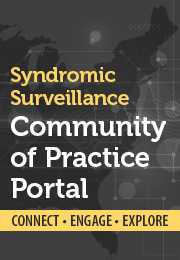NSSP Funding Opportunity Announcement (FOA) (archive)

The mission of the National Syndromic Surveillance Program is to promote the use of high-quality syndromic surveillance data. These data help public health officials make informed decisions to better protect America’s health, safety, and security. Ultimately, having better, more representative syndromic surveillance data will improve nationwide all-hazard situational awareness and responsiveness to hazardous events and outbreaks.
Go to Grants.gov and search for federal grants by keyword or specific criteria.
The National Syndromic Surveillance Program: Enhancing Syndromic Surveillance Capacity and Practice
The purpose of the NSSP funding opportunity is to assist state and local public health authorities in implementing syndromic surveillance to enhance situation awareness and to detect and characterize disease outbreaks or other hazardous events or conditions of public health concern and respond quickly to local threats. In addition, the NSSP provides support to state and local health authorities to advance the Meaningful Use of syndromic surveillance data from electronic health records (EHRs).
Activities that will be supported to enhance syndromic surveillance capacity and practice include
- improving the overall representativeness of syndromic surveillance data by recruiting hospital or other sources of emergency department/urgent care or inpatient data that are representative of the jurisdiction’s population;
- improving the quality, timeliness, utility, and sharing of these data; and
- increasing collaboration among state and local jurisdictions through a national syndromic surveillance Community of Practice.
The NSSP includes a cloud-based syndromic surveillance platform that hosts an electronic information system and other analytic tools and services. The Association of State and Territorial Health Officials (ASTHO), through a cooperative agreement with the CDC, supports the cloud-based infrastructure for the platform and develops data-use agreements with participating state and local health departments. CDC complies with the directive in the Public Health Service Act to develop a nationwide system, and the need to enter into the DUA is furtherance of achieving that directive. Public Health Service Act, section 319D(d)(1) directs the establishment of “…a near real-time electronic nationwide public health situational awareness capability through an interoperable network of systems to share data and information… .”
Additional Information:
- Page last reviewed: October 31, 2016
- Page last updated: March 29, 2016
- Content source:




 ShareCompartir
ShareCompartir